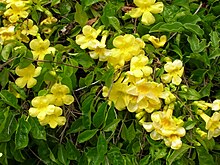Dolichandra unguis-cati, commonly known as cat's claw creeper, funnel creeper,[2] or cat's claw trumpet,[2] is a rapidly growing climbing vine belonging to the family Bignoniaceae.[3] It affects all plant layers of the forest ecosystem spreading rapidly both vertically and horizontally.
| Dolichandra unguis-cati | |
|---|---|

| |
| Scientific classification | |
| Kingdom: | Plantae |
| Clade: | Tracheophytes |
| Clade: | Angiosperms |
| Clade: | Eudicots |
| Clade: | Asterids |
| Order: | Lamiales |
| Family: | Bignoniaceae |
| Genus: | Dolichandra |
| Species: | D. unguis-cati
|
| Binomial name | |
| Dolichandra unguis-cati | |
| Synonyms[1] | |
|
List
| |
Description
editDolichandra unguis-cati is a liana with semipersistent foliage and woody stems that can reach a height of 30 metres (98 ft). Thin and small aerial roots are used for climbing. Leaves are dark green, opposite and bifoliate. Leaflets have a length of 3 to 4 cm (1.2 to 1.6 in). Long primary roots extend beneath the soil surface, producing large tubers 40–50 cm (16–20 in) long.[4]
Flowers are yellow, have a diameter of 4 to 5 cm (1.6 to 2.0 in) and can grow alone or in groups of two or three. Flowers occur from late spring through to early summer.[5] Their calyx is narrow trumpet-shaped, 1–2 centimeters long. Their corolla is also tubular and measures 4 to 10 centimeters long. The 5 lobes of the corolla have different sizes. The opening diameter is 1.2 to 2.4 centimeters. Fruits are brown flattened capsules from 25 to 95 cm (9.8 to 37.4 in) long. Each capsule contains 100 to 200 seeds.[4]
Distribution and habitat
editThis plant is native to the tropical dry forest of Central America, South America (Mexico to Brazil and northern Argentina) and the Caribbean. In these natural areas it occurs from sea level to over 600 metres (2,000 ft) above sea level and where the rainfall is 750 to 2,400 mm (30 to 94 in) per year. It can become invasive due to its fast growth and it is present worldwide, often having been introduced as an ornamental plant to these regions. It can affect all layers of plants of forest ecosystems by rapidly spreading both vertically and horizontally.[4]
It prefers fertile, well-drained soils but can survive in most soils except salty ones. It tolerates the lack of light well, but grows faster in the sun. It is naturalised in Australia, southeastern US, southern Africa, tropical Asia. It grows in orchards and gardens, roadsides and grasslands, in open urban areas, especially in temperate to subtropical regions with medium to high rainfall. It spreads both horizontally, in contact with herbaceous plants, and vertically, up to the canopy.[4]
Invasiveness
editThe eradication of this plant is difficult because of its rapid spread linked to the vast root system it develops and the profusion of its seeds. It survives grazing and wildfire, and disturbances tend to stimulate offspring production. The plant is said to be "one of the most destructive exotic vines", where it is especially aggressive in riparian zones and rainforest communities where it strangles trees.[4]
Medicinal use
editIts use has been documented as an antidote for snake bites in folk medicine. It is also used to treat dermatitis, in addition to being antipyretic. Furthermore, being anti-inflammatory, it has been used for the treatment of intestinal ailments, venereal disease, rheumatism, dysentery, malaria and oliguria. Its leaves revealed antitumoral and antitrypanosomal activities.[6]
Gallery
editReferences
edit- Notes
- ^ "The Plant List: A Working List of All Plant Species".
- ^ a b "USDA GRIN Taxonomy". Archived from the original on 2013-04-09.
- ^ "Cat's claw creeper (Macfadyena unguis-cati)". Brisbane Rainforest Newsletter; Brisbane Rainforest Action & Information Network. April 1996. Archived from the original on 15 December 2012. Retrieved 15 May 2013.
- ^ a b c d e Plantinvasivekruger - Bignoniaceae - Dolichandra unguis-cati (L.) L.G.Lohmann Plant Net. Retrieved 25 April 2022.
- ^ Cat's claw creeper Brisbane City Council Weed Identification Tool
- ^ Aboutabl, E. A.; Hashem, F. A.; Sleem, A. A.; Maamoon, A. A. (2007). "Flavonoids, Anti-Inflammatory Activity and Cytotoxicity of Macfadyena Unguis-Cati L". African Journal of Traditional, Complementary and Alternative Medicines. 5 (1): 18–26. doi:10.4314/ajtcam.v5i1.31251. PMC 2816596. PMID 20162050.
- Bibliography